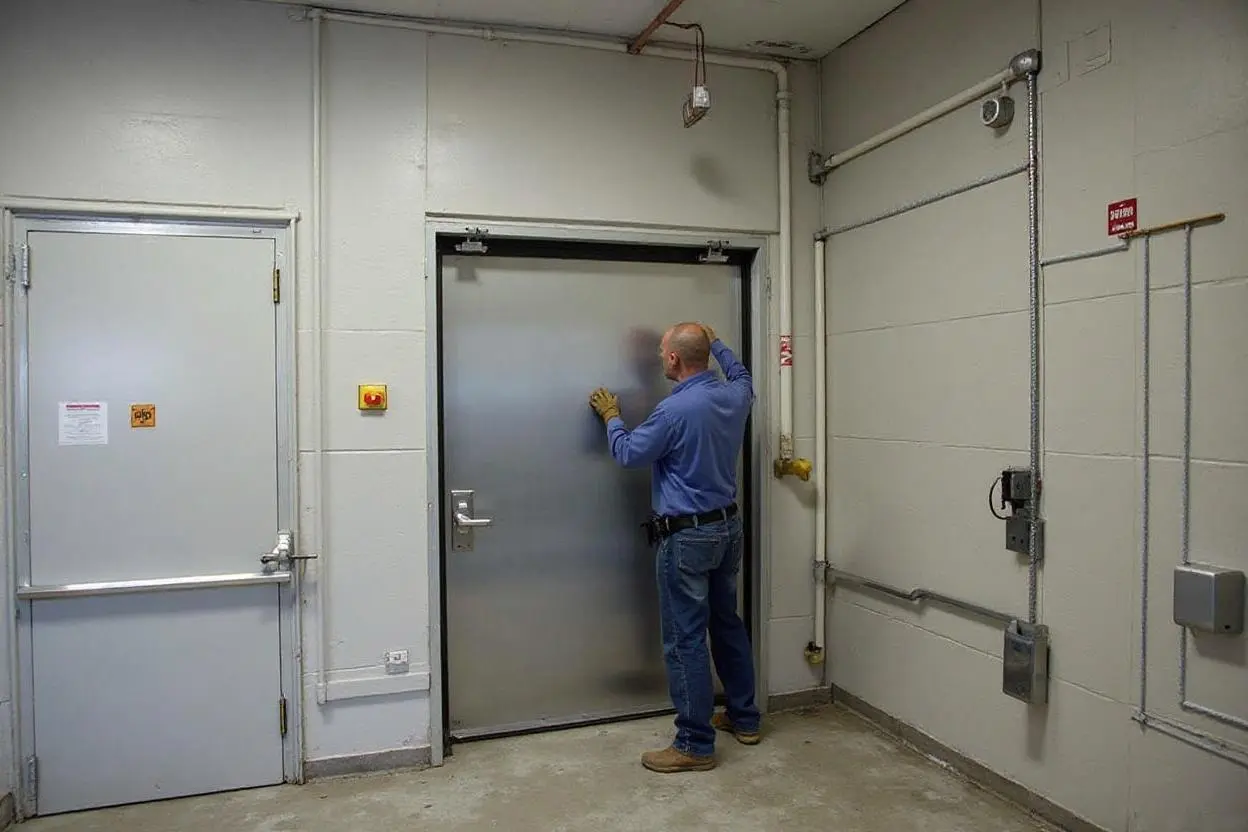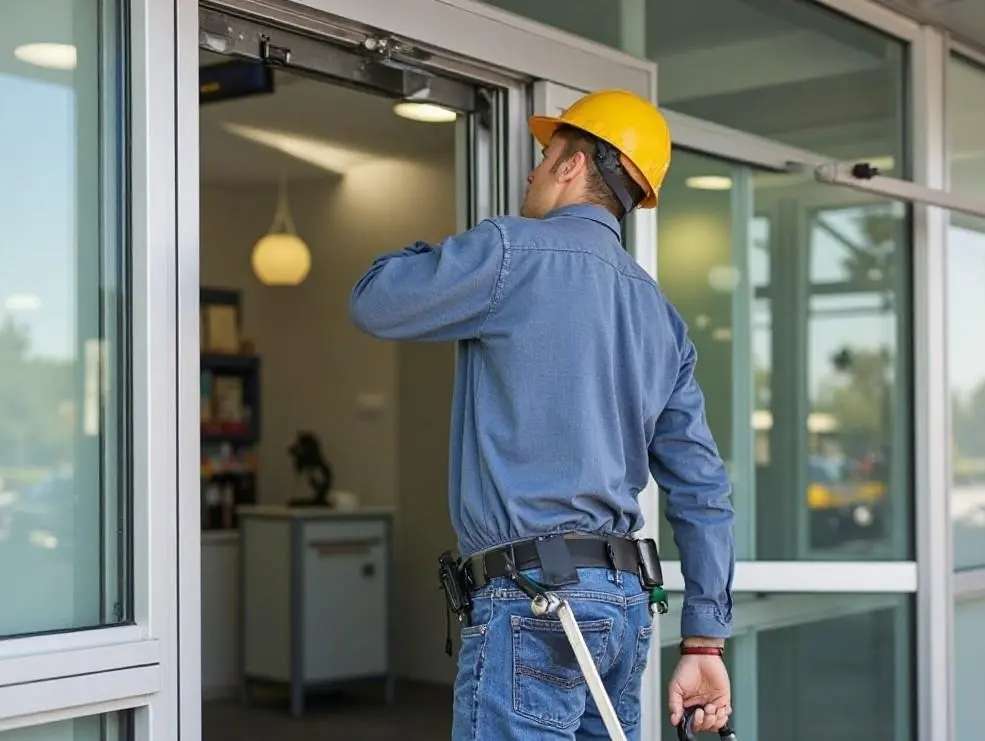How Often Do Automatic Doors Need To Be Serviced?
Automatic doors are workhorses. They cycle hundreds or thousands of times a day, carry heavy panels, and depend on sensors that must read movement precisely. In Buffalo, NY, lake-effect snow, salt, and temperature swings add extra stress. The right service schedule keeps doors opening smoothly, keeps people safe, and avoids downtime that frustrates customers and tenants.

The short answer most buildings can use
For most commercial buildings in Buffalo, plan professional automatic door maintenance every 3 to 6 months. High-traffic sites do better on a quarterly schedule. Lower-traffic offices can stretch to twice a year. Doors at hospitals, supermarkets, and transit facilities should be checked monthly. This cadence aligns with ANSI/BHMA A156 safety expectations and what technicians see in the field.
What changes the frequency in Buffalo
Traffic volume drives the schedule more than anything else. A grocery entry on Elmwood Avenue may see 1,500 to 4,000 cycles daily. A medical clinic on Delaware Avenue might see 400. More cycles mean more wear on rollers, belts, pivots, and operators.
Weather is the second force. Buffalo winters push slush into thresholds. Ice can bind bottom rails and strain the operator. Spring brings grit and salt residue that can scratch guides and confuse sensors. Wind gusts on Main Street can slam a leaf mid-swing if the control board is out of tune. Buildings near the waterfront see more corrosion on hardware, which calls for closer inspection.
Door type matters as well. Sliding doors need track and roller attention. Swing doors need pivot and closer checks, along with arm and gearbox inspection. Folding doors combine both kinds of stress. Revolving units have their own speed and brake requirements and usually sit on a monthly service plan in busy buildings.
What “service” should include
A good visit is not a quick wipe-down. It follows a method that protects users and the operator. Here is what a technician checks and adjusts during automatic door maintenance that keeps systems safe and reliable:
- Safety sensors: Test presence sensors, thresholds, and side screens. Confirm detection zones match foot traffic and ADA needs. Re-aim or replace faulty eyes.
- Mechanical wear points: Inspect rollers, tracks, pivots, hinges, belts, and gearboxes. Adjust tension, lubricate with the correct product, and replace parts that show flat spots or play.
- Operator controls: Verify opening and closing speeds, hold-open time, and braking. Update settings for winter stack pressure and wind load. Check error logs where available.
- Door alignment: Confirm plumb and level, latch engagement for secure close, and weatherstrip contact to prevent drafts and icing.
- Life-safety tests: Run impact checks, redundant sensor checks, and emergency breakout or manual mode. Document results for your life-safety file.
On a typical quarterly call in Buffalo, a technician often clears packed salt from thresholds, resets opening speeds slowed by cold, and replaces at least one worn roller or belt section on heavy-use sliders.
Signs you should not wait for the next visit
An owner or facility manager rarely sees the internal wear, but a few user-facing changes mean it is time to book service now. If a door starts to chatter on opening, pauses mid-travel, reopens without a person present, or leaves a gap at close that you can see daylight through, call. A faint burnt smell from the header after a busy weekend hints at an operator straining. Another warning is a change in sensor behavior, such as doors opening when pedestrians pass 8 to 10 feet away on the sidewalk in light wind — that often means a misaligned or over-sensitive sensor.
Why a set schedule saves money
Emergency calls at 7 p.m. on a Sunday cost more than a planned weekday maintenance slot. More important, an ignored roller or belt can take out a gearbox. In one Elmwood Village retail case, a $75 roller ignored for two quarters chewed through a $1,100 operator. Downtime turned a busy entry into a single manual door for two days, and sales dropped for that stretch.
Routine service also protects liability. If a sensor misses a person and there is an injury, the first question is when the door was last tested. Documented service with pass results reduces risk and supports compliance with ADA and ANSI standards.
A Buffalo-specific maintenance rhythm
Many Buffalo facilities run a hybrid plan that responds to seasons:
- November to March: Quarterly plus a mid-winter check for sites with heavy snow. Focus on thresholds, weatherstripping, and ice-related binding.
- April to June: Spring clean and re-aim sensors after doorways have shifted slightly from freeze-thaw. Remove salt residue from tracks.
- July to September: Heat can thin lubricants. Recheck speeds, door weight balance, and belt tension. Summer foot traffic increases at tourist sites and campuses.
- October: Pre-winter tune to tighten closures, replace brittle sweeps, and verify fail-safe operation before the first big storm.
This pattern keeps small issues from turning into holiday closures or storm-day failures when people depend on smooth entry.
What owners and managers can do between visits
A technician handles adjustments and part replacements, but staff can protect the investment day to day. Clear snow from thresholds promptly. Do not use rock salt directly in tracks; calcium chloride pellets near but not inside the track work better. Keep mats trimmed so edges do not ride into the slider path. Ask janitorial crews to avoid spraying glass cleaner into sensor lenses. Report odd sounds or behavior the same day. A quick call prevents a larger repair.

Typical service intervals by site type
- Hospitals and 24/7 healthcare in Buffalo: monthly inspections, with faster response coverage.
- Supermarkets, pharmacies, and big-box retail: every 2 to 3 months, shifting to monthly for peak seasons.
- Offices and multi-tenant buildings: every 4 to 6 months, with a winter check.
- Schools and campuses: quarterly during semesters, pre-semester tune for main entries.
- Hospitality and entertainment venues: quarterly, plus pre-event checks for arenas and theaters.
These are starting points. Actual schedules adjust based on cycle counts. If an entry if firing over 1 million cycles per year, quarterly becomes the minimum and some parts move to replacement on a calendar basis.
How A-24 Hour Door National Inc approaches maintenance
A-24 Hour Door National Inc services automatic doors across Buffalo and the surrounding suburbs — Amherst, Cheektowaga, Tonawanda, West Seneca, Orchard Park, and Niagara Falls. The team logs baseline settings on the first visit and documents each change. That record helps diagnose intermittent issues quickly. Technicians carry common wear parts for Stanley, Horton, Nabco/Gyro Tech, Besam/ASSA ABLOY, record, and dormakaba systems to cut repeat trips.
Each maintenance visit includes a written checklist with pass/fail on safety tests, current speed and hold-open settings, photos of worn parts replaced, and notes for the next visit. Facilities appreciate clear records during insurance audits and AHJ reviews.
Costs and budgeting
Quarterly maintenance per opening is usually less than one emergency night call. Most Buffalo businesses budget per door, with volume pricing for multi-door sites. Doors that handle severe weather or that face prevailing wind may need more frequent roller and weatherstrip replacements. A-24 Hour Door National Inc can map each entrance, set the right interval, and project part replacements by season so budgets stay realistic.
Common Buffalo failure patterns and fixes
Technicians see repeat patterns by neighborhood and exposure. Downtown corridors see wind-driven false opens; narrowing the activation zone and adding wind shields on sensors helps. South-facing glass entries in summer can reflect sunlight into sensors; swapping to polarized or curtain-style presence sensors reduces nuisance triggers. Doors near parking lots collect brake dust and grit that packs tracks; more frequent vac and lube stops extend roller life. In winter, heaters above the header that blow directly on sliding door sensors can cause drift; small deflectors and sensor recalibration solve it.
Ready benchmarks for your team
Use three practical benchmarks to decide your cadence. First, count cycles if possible; many operators track them. Over 3,000 cycles per day points to quarterly or better. Second, watch your call history; two or more unscheduled calls in six months means the current interval is too long. Third, consider exposure; any door that sees snow intrusion or constant wind deserves more frequent checks.
Book service in Buffalo, NY
If an automatic door drags, slams, or keeps opening without a person present, it is time to schedule. A-24 Hour Door National Inc offers routine automatic door maintenance, safety testing, and 24/7 repair across Buffalo and nearby towns. Call to set a quarterly plan or request a one-time safety inspection. A technician can review your entries, set cycle-based intervals, and keep your doors moving through every Buffalo season.
A-24 Hour Door National Inc provides commercial and residential door repair in Buffalo, NY. Our technicians service and replace a wide range of entry systems, including automatic business doors, hollow metal frames, storefront entrances, fire-rated steel and wood doors, and both sectional and rolling steel garage doors. We’re available 24/7, including holidays, to deliver emergency repairs and keep your property secure. Our service trucks arrive fully stocked with hardware, tools, and replacement parts to minimize downtime and restore safe, reliable access. Whether you need a new door installed or fast repair to get your business back up and running, our team is ready to help. A-24 Hour Door National Inc
344 Sycamore St Phone: (716) 894-2000 Website: https://a24hour.biz/buffalo
Instagram: @a24hourdoor
Buffalo,
NY
14204,
USA
Facebook: 24 Hour Door
Yelp: A-24 Hour Door National (Buffalo)
X (Twitter): @a24hrdoor